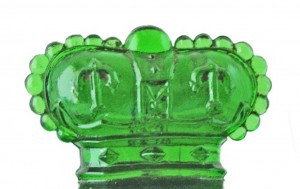A Story of Salts, Scents and Society
With the creation of Crown Lavender Salts, William Sparks Thomson transformed a mundane, medicinal necessity into the world’s most frequently used brand of smelling salts — simply by adding the very best lavender essence and placing this fragrant salt in an unmistakable emerald green bottle with a crown stopper. This very versatile, sweet smelling product was used to alleviate headaches, fainting spells, motion sickness and other complaints. For Thomson, Crown Lavender Salts was his most important product.
His second most important product was Crab Apple Blossoms (Malus Coronaria) perfume, a delightful and delicate perfume worn alone or layered with another Crown favorite, Matsukita. Crown was the first perfumery to create a perfume from the fragrant blossoms of the crab apple tree.
The genius and legacy of The Crown Perfumery Company were perfumed products that were used for decades, by everyone, everywhere.
The history began in New York where William Sparks Thomson was manufacturing perfume and soap prior to the London establishment. This one sentence, found in a 1921 legal document, is all the information I have on a pre-London perfumery.
The Crown Perfumery Company was established in London in 1872. The earliest date found is March 2nd, 1872 for a bottle and stopper design registered with the British government. The Maltese cross design for labels was registered on May 14th, 1872.
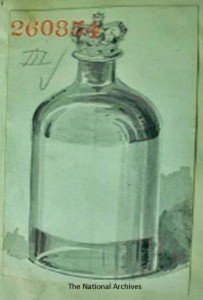
1872 Registered Design
The National Archives
The two perfume bottles below both bear the Register Design number 260854 and both have the Maltese cross label. The difference occurs in the names of the company on these paper labels. The first bottle has “Thomson’s Crown Perfumery Co.” while the second bottle has “The Crown Perfumery Co.”
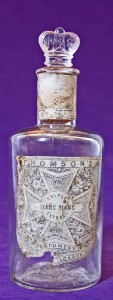
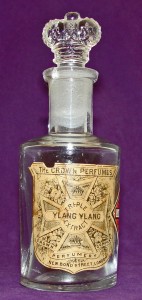
Thomson’s Crown Perfumery Co. The Crown Perfumery Co.
5.5″ 14 cm 4.75″ 12.1 cm
The “Thomson’s Crown Perfumery Co.” label is shown in newspaper ads in Jamaica (1884) and in 1885 ads in Dutch East Indies (Indonesia) and Dutch Guyana (South America). In 1874, “The Crown Perfumery Co.” label is shown in an April ad from Godey’s Lady Book, an American monthly magazine.
The bottle above, the 1884/1885 advertisements and the calling card below are the only items I have seen with “Thomson’s Crown Perfumes/Perfumery.” Why the difference in company names? Why is “Thomson’s Crown Perfumery” being used a decade after the establishment of The Crown Perfumery Company? And why does Thomson’s personal business card, circa 1874, state “Thomson’s Crown Perfumes”?
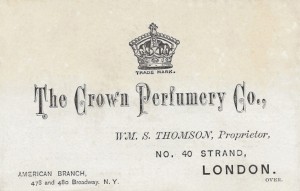
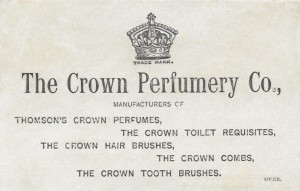
c. 1874
By the 1870s, Thomson was already world famous for “The Crown Skirts,” the indestructible cage crinoline (the hoop skirt) and “Thomson’s Glove Fitting” corsets. For years Thomson had been stamping his name and crown trademark on all of his garments. It was only natural to name his new venture “Thomson’s Crown Perfumery Co.” Why he chose another name for his London company is unknown, but continuing to use “Thomson’s Crown Perfumes/Perfumery” provided additional cachet to the fledgling firm. Associating Thomson’s name with his new perfume venture would transfer the superior quality of his clothing to his perfume. As time progressed and the perfumes became household items around the world, the name and reputation of The Crown Perfumery Company were able to stand alone.
At the present day no lady’s or gentleman’s toilet table is complete without a bottle of choice Perfume. THE CROWN PERFUMERY COMPANY, No. 40, Strand, London, have lately introduced some new and choice scents, distilled from the rarest and choicest flowers, and they appear from their delicacy and fragrance to be equal, if not superior, to anything ever before offered to the public. Every reader should ask for any one of the following: Meadow Queen, Wild Flowers of India, Mathiola, Butterfly Orchis, Crown Bouquet, Hawthorn Bloom. June 12, 1872 [2]
For the next fifty years, Crown perfumes would grace the vanity tables within palaces, mansions and cottages. Over 150 different named fragrances would be created with an exceptional delicacy, purity and strength. Their bottles would be placed in silver holders and adorned with silver overlay. Baccarat would produce bottles for three different perfumes (Parfum Adorable, Soupir d’Amour and an unknown fragrance).
Recognized by peers in London and abroad for their fine fragrances, Crown received awards early on from two major exhibitions in 1873. Numerous awards would follow.

Stationery Letterhead, 1895
Crown’s “scent shop” was first located at 40, The Strand, in London’s Theatre District. From 1872 to 1878 they sold perfumes, perfumed fancy soaps, cosmetics, tooth powders and hair lotions at this location. Today, it seems odd that an elegant perfume house would sell such toiletries, but it was not an oddity in the later part of the nineteenth century. Guerlain, Ed. Pinaud, L.T. Piver and Rimmel also carried these toilet requisites during this time.
The excellent reputation of their products required an elaborate new store with an elegant address. In the first months of 1878, The Crown Perfumery Company opened new premises at 177, New Bond Street, London. Here in one of the world’s finest shopping districts, perfumes of the highest concentrations were offered in bottles and packaging of the highest quality.
Society took notice and stepped into a store filled with exquisite perfumes, sachets and lotions. There were fans for evening soirees and soft kid leather gloves in a variety of colors. Beveled mirrors with thick silver filigree atop dark velvet were displayed. There were trays, trinket boxes, photo frames, inkstands and table screens. Society came, bought and returned again and again to purchase more.
It is absolutely necessary for the would-be society person to gain some little acquaintance with the appearance, manners, liveries, and distinguishing characteristics of the various members of the British nobility, so that Milord the Baron may be known from His Grace the Duke, and Premier Gladstone from the Hon. Fitzhugh of the Guards. This can be done, and easily. The way is simply this. Go to Bond street and either enter or take a commanding position near the store of the Crown Perfumery Company. All the nobility and a plentiful sprinkling of royalty go there, and among those whom a glance at the Company’s books reveals as regular patrons are the following: The Princess of Wales and Princesses Battenberg, Nensy, Monaco, Hatzfeldt, and Daria; The Duchesses of Albany, Sutherland, Cleveland, Newcastle, Devonshire, Leinster, Portland and Marlborough; the Countesses Bentwick, Dunraven, Sefton, Rosslyn, Gainsborough, Russell, Steinlock, Montebello, Yarborough and Lovelace; the Vi-Countesses Westmoreland, Galway, Castlense, Cross and Hood; Baronesses Burdett-Coutts and Reulae; Marchionesses Fezeusac de Montisarro and Cunningham; and Ladies Alington, Beresford, Broderick, Butler, Brougham and Vaux, Barming, Bulkeley, Brassey, Brooke, Crossley, Campbell, Castledown, Randolp Churchill, Cardross, Cottonham, DeWalton, Harcourt, Playfair, Lonsbrough, DeGrey, Goldsmidt, Hillingdon, Gerard, Monckton, Scott, Street, DeTrafford, Wemmys, Dundas, Hamilton, Thompson and Somerset. Besides the husbands of these noble ladies the masculine patrons number such gentlemen as the Duke D’Oastia, Lord Abercrombie, Lord Durham, Lord Sandhurst, Lord Neville, The Turkish Ambassador, Earl Faversham, Marquise Abergavemy, Count Alderberg, Sir Cuthbert Slade and Col. Fitzgeorge. October 1st, 1893 [3]
Should a woman not be of the elevated rank or social standing as those noted above, she also felt like royalty with her purchase of Crown perfumes from a department store or local drugstore, where many of the same fragrances were offered in a standard plain bottle and box rather than an elaborate cut crystal or silver adorned bottle.
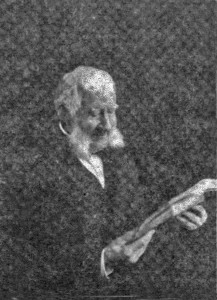
William Sparks Thomson, 1902 [4]
In 1885 when William Sparks Thomson combined spirit of lavender with ammonia carbonate, he created a product that households required, hospitals needed and passengers traveling by carriage, rail or ship requested. It was an ingenious solution and an immediate success. Crown Lavender Salts became the principal product of The Crown Perfumery Company. By 1890, over 300,000 bottles were being sold annually. That number was raised to one half million bottles by 1892. Advertisements for Crown’s perfumes frequently had a reference to Crown Lavender Salts, thus providing instant name recognition and reputation for the perfume.
Crown Lavenders Salts were placed in round, emerald green glass bottles with the famous crown shaped stopper. For a beautiful presentation in the boudoir or drawing room, the bottle was placed in a silver holder that was monogrammed, filigreed or embossed. Travel size bottles in kid leather pouches were very popular as society began to travel farther distances.
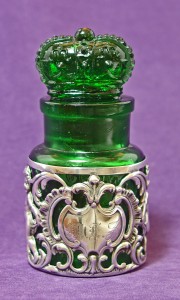
3.25″ / 8.2 cm
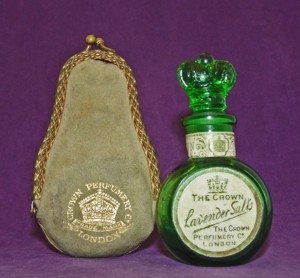
3″ / 7.6 cm
Crab Apple Blossoms was another original invention for The Crown Perfumery Company. July 1886 is the earliest date I have for this classic perfume, the inspiration coming from a stately and fragrant tree on the lawn of Thomson’s London home. A short two years later, eight prize medals had been awarded to Thomson’s most successful perfume.
A groundbreaking concept in perfumery was Crown’s Matsukita du Japon, introduced in 1892. This perfume could be layered over Crab Apple Blossoms for a deep, rich, long-lasting scent for those festive evening balls and opera engagements.
Crown perfumes were celebrated for the purity of their ingredients and their high concentration of essential oils. In an age of single note floral perfumes, using the finest natural essential oils in a refined alcohol base gave the company its well-deserved reputation and its edge over their competitors. Early in the company’s history, Thomson’s youngest child, Charles, realized that the quality of a perfume was greatly affected by the grade of alcohol spirit used to distill the perfume. Even though corn-based spirits were prominently used in English perfumes at the time, Charles declared that only the finest and purest spirit would be used for the Crown perfumes. In 1879, a dedicated spiritine factory was built in Palmer’s Green, London to manufacture spirits in the “French grape” method, thus ensuring that the Crown products met the same high standards as the French perfumes.
Although classic shapes, the round green glass bottle for Crown Lavender Salts and the square clear glass bottle for the fragrances were not the only style of bottle used. The salts bottle was shaped like a watch for the Pocket Salts series. The perfumes were offered in heavier glass with hand cut faceted stoppers, in silver overlay and in crystal bottles. Patented sprinkler topped bottles were used for their colognes, toilet waters and some perfumes. The variety of bottles kept society coming back for more. New bottle designs refreshed the image and new labels modernized the brand based on new trends.
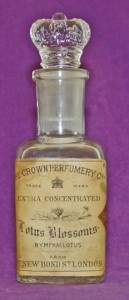
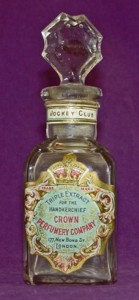
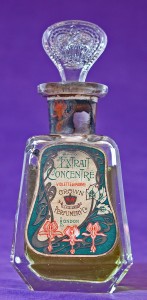
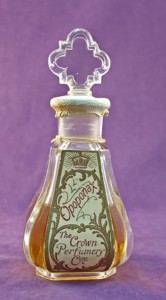
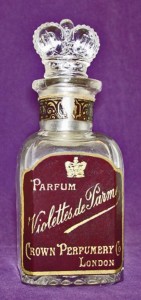
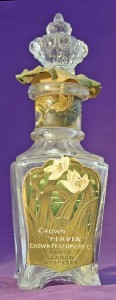
A range of bottle and label designs. Bottle heights range from 4″ / 10.2 cm to 5″ / 12.8 cm
The higher end perfumes had packaging which was unique to each perfume. The Paris office designed and manufactured bottle labels along with show-cards used for store advertising and exhibition displays.
London was the center of operations for The Crown Perfumery Company, but by no means was it the only center of manufacture. Connecticut, Copenhagen France, Hamburg and Vienna had significant production facilities. Berlin, New York and Paris had noteworthy showrooms. Salesmen traveled to all six continents to showcase their products to merchants and brought home large orders which were promptly filled.
I need to diverge a bit to provide background into Thomson’s clothing and perfume companies and their close inter-relationship. The clothing companies manufactured mantillas, overskirts and underskirts, crinolines, hoop skirts and Glove Fitting Corsets.
In New York, the clothing companies were:
WS Thomson, 1854 – 1856
WS & CH Thomson, 1856 – 1861
WS Thomson, Langdon & Co., 1861 – 1889
Langdon, Batcheller & Co., 1889 – 1901
George C. Batcheller & Co., 1901
In London, the clothing companies were:
WS & CH Thomson, 1859 – 1868
WS Thomson & Co. 1868
Basically, the New York companies sold to the United States, while the London companies sold to the rest of the world. New York did not begin manufacturing the highly successful Thomson’s Glove Fitting Corset until 1877 when a factory in Bridgeport, Connecticut was built. From 1865 – 1877, New York was the sole importer into the United States for these corsets.
In London, the perfumery company was:
The Crown Perfumery Company, 1872
In New York, the perfumery companies were:
The Crown Perfumery Company of New York ( c.1888 – 1899)
The Crown Perfumery Company of New York (via George C. Batcheller), 1899-1907
Charles H. Langdon was Thomson’s close friend since their days in Hartford, Connecticut where they both had dry goods stores on the same street. Langdon would join forces with Thomson in New York in the 1850s, becoming the managing partner while Thomson and his brother headed off to Europe to expand the business. Between 1872 and 1888, all products of The Crown Perfumery Company were imported into the United States by Thomson, Langdon & Co.
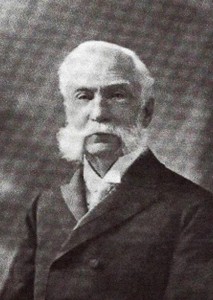
Charles H. Langdon, c. 1898 [5]
William Sparks Thomson took a special interest in the American perfumery business around 1888. He was the sole stockholder of this “American Branch.” Perfumes and supplies were shipped in bulk from London to Connecticut, with the business being managed first in New York, then in New Haven. Thomson increased advertising and personnel for the American market with great results. Recognition and recommendations from society propelled sales growth.
In 1899, at 76 years of age, Thomson sold his interest in The Crown Perfumery Company of New York to George C. Batcheller, Edward W. Russell and Henry Miller. Even though Thomson retained royalties on the profits, this arrangement was a disaster. Thomson accused Batcheller et al. of harming sales and of producing a cheap bath powder, Bathasweet, in direct competition to Crown’s finer, more expensive bath powder, Bathadora. Sales of Crown perfumes and toiletry items dropped dramatically in the United States during the duration of the seven year contract.
Fortunately the contract expired in 1907. Unfortunately, Crown’s American reputation was in tatters. Charles E. Thomson brought a team from London, headed by Mrs. Mary H. Sanders, to rebuild the American market. With hard work and high quality perfumes once again being sold in the United States, the team tripled their accounts and brought innovative ideas and Crown products once again into the homes of American society.
William Sparks Thomson died at his London home, Sidmouth Lodge, on November 27th, 1907. He had transferred his interests in The Crown Perfumery Company (London) to his son Charles and daughter Annie on July 17th, 1899.
With Charles in control, the company continued its worldwide growth. Charles had grown up with the perfume company and had been in the executive suite for years. He introduced many new perfumes and exciting products: Crown Lavender Salts was revitalized as “atmospheric perfumes” with gorgeous sterling silver holders; Lune de Miel made its debut in 1910; Iroma in 1911; and Baccarat became a supplier of crystal bottles starting in 1910.
During the years of the Great War, Crown faltered. Flower fields in Europe were no longer planted, cultivated or harvested. Factories belonging to The Crown Perfumery Company in Austria, Denmark, France and Germany were either closed, destroyed or the machinery was refitted for the production of war necessities. Employees went to fight for their countries. Glass manufacturers suffered the same debilitating consequences. For Crown and other perfumers, obtaining large quantities of perfume bottles was nearly impossible.
In 1920, William Thomson, the eldest child, was 65 years old; Annie 63; and Charles 57. They had not married and there were no children to carry on the business. Crown’s perfumes, fancy soaps, fragrant lotions and powders still had a following, but the company would not remain in the family. An agreement to sell The Crown Perfumery Company was signed on June 30th, 1921 between the three Thomson children and William Gossage & Sons Ltd., a soap manufacturer. On January 18th, 1921, The Crown Perfumery Company Ltd. was incorporated. The American rights were sold on April 26th, 1922.
Although William Gossage & Sons concentrated on soaps, they continued producing some of the old Crown favorites, even introducing a successful new line — The Crown Toilet Dainties. They held a design patent for a reusable powder spray, the Crown Talcpuf.
The one product which survived the longest was William Sparks Thomson’s most important product – Crown Lavender Salts. The Crown Lavender Salts bottle remained the same rounded emerald green glass bottle with its crown shaped stopper, but the embossing was changed to “The Crown Perfumery Company Ltd. London Paris New York.”
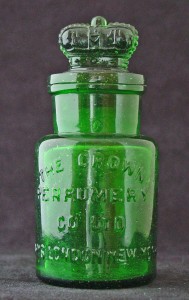
4″ / 10.2 cm
The last advertisement I have seen for Crown Lavender Salts is dated September 1948 for this small glass bottle with a Bakelite cap. The distributor is Schiefflin & Co., New York. The same bottle has been spotted with distributor “Almay Inc., New York, NY” on its label, which would be after 1931 and possibly as late as the 1960s.
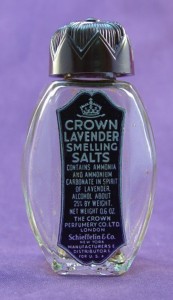
2.5″ / 6.3 cm
William Gossage & Sons, Ltd., the parent company of The Crown Perfumery Company Ltd., was itself a subsidiary of another soap manufacturer, Lever Brothers. In 1930 Lever Brothers merged with Margarine Unie, a Dutch company, resulting in the new firm Unilever. Deep in their archival vaults, Barry H. Gibson found a dusty, forlorn company. He stripped the cobwebs away, refreshed the formulas, polished the bottles and re-launched The Crown Perfumery Company in 1994.
It took ten years of research and reformulation, but his efforts were worth it. The Crown Perfumery Company of the 1990s captivated a loyal following. Matsukita, Tanglewood Bouquet, Crown Imperial, Buckingham and many others were once again placed on shelves after decades of being absent. Society once again found favor with Crown perfumes.
Seventeen perfumes for women and eleven for men were sold in spray bottles reminiscent of Thomson’s original designs. A crown graced the all-natural perfumes. Perfumed soap and lotions were also brought back.
The very talented British luxury furniture designer Clive Christian purchased The Crown Perfumery Company in 1999. The last manufacturing order of Crown perfumes was in 2001. Christian now creates exquisite pure perfumes for Clive Christian Perfume Company Ltd.
[2] Pall Mall Gazette (London). 12 June 1872. Advertisements.
[3] The Pharmaceutical Era. 1 October 1893, 329.
[4] “Founder of the Crown Perfumery Company.” American Druggist and Pharmaceutical Record. 13 January 1902, 8.
[5] Men of Progress. Biographical Sketches and Portraits of Leaders in Business and Professional Life in and of the State of Connecticut. Compiled under the supervision of Richard Herndon. Edited by Richard Burton. Boston: New England Magazine. 1898, 200.
